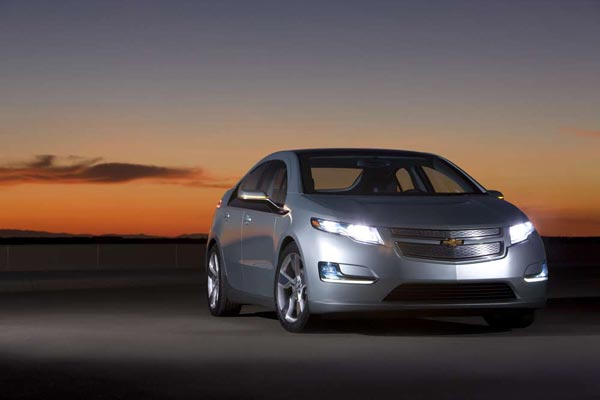 Has the 21st century finally caught up with the Jetsons? We’re on our way with the current modes of transportation available. Flying cars and morphing planes are estimated to cost around $220,000 and still have a long way to go to become main stream – if ever. The link with the Jetsons is that their vehicles ran on electricity and so does the All-New Chevrolet Volt.
Has the 21st century finally caught up with the Jetsons? We’re on our way with the current modes of transportation available. Flying cars and morphing planes are estimated to cost around $220,000 and still have a long way to go to become main stream – if ever. The link with the Jetsons is that their vehicles ran on electricity and so does the All-New Chevrolet Volt.
The 2011 Chevy Volt has been a key project for General Motors to help propel them forward as a leader in the high-tech development of electrically-operated vehicles. The Volt is a hybrid, however, different than the customary hybrids that are powered by both a gas and an electric motor. All the power that drives the front wheels on the Volt come from an AC-current electric motor. There are two ways to charge the batteries that feed power to the electric power plant.
Drivers can charge the car using either a 110-volt plug or for a fast charge (about four-hours), a 240-volt charging station. Chevrolet claims your standard 110-volt outlet will fully charge the batteries in 10 to 12 hours and provide around 25 to 50 miles on a charge based on terrain, driving techniques and temperature at a fee of between $1.00 to $1.50 per day. My experience is that after a 12-hour charge, I personally experienced between 34 to 37 miles based on the dash read-out. For ease and convenience, merely plug the Volt in to a power outlet via a special plug and power unit provided with the car.
The second way to recharge the batteries is via the 1.4-liter gasoline motor, which kicks in when the system detects the batteries are getting low on “juice”. This is one of the main differences between the Volt and other hybrids; the gas engine never directly powers the wheels. The 84-horsepowered 1.4-liter, 4-cylinder extends the driving range by 350 miles. During my week of test driving the Volt, the gas gauge moved just slightly.
Chevrolet did an excellent job with the Volts power system. The transition is smooth as the engine quietly kicks in to charge the 288-cell-battery pack when needed. Having the second charging source allows you to make your trips in confidence not worrying if the batteries will go dead while being stuck in traffic or having to make a few last minute stops.
The model lineup is simple as the 4-door, 4-passenger Volt sedan ($41,000 including destination) comes in only one trim line. However, you can accessorize by adding a Premium package ($1,395) that includes heated front seats, perforated leather upholstery, premium door trim and leather-wrapped steering wheel, Rear Camera with Park Assist ($695) and polished alloy wheels ($595).
When the Volt concept was introduced four-years ago it was crafted with a beautiful futuristic profile. Over the development period with the goal of making the Volt as aerodynamically efficient as possible, the edges and lines took on a more rounded appeal, while continuing its distinguishable styling. The Volts wide stance and sculptured belt line delivers a performance-oriented stance.
The interior of my test model featured black door panels, dash and leather seats with bright silver appointments on the center console and around door switches, center cup holders, and door pulls. Smooth white plastic flows across the front of the center console and other parts of the trim. As you sit in the driver’s seat you are greeted with two large 7-inch high-resolution full-color screens. The first one is the reconfigurable graphic instrument panel featuring your speed, battery charge, fuel amount and other elements that help you drive as fuel efficiently as possible.
The second screen is located in the center stack and includes a touch screen display for radio, climate controls, navigation, and backup camera view. The start power-button located on the center console, jumps out with its bright blue glowing color with silver trim.
The two rear bucket seats are divided by a center console with cup holders. Both seats can be folded flat to provide more storage space. Rear legroom can be a bit tight if a tall driver or passenger is located up front, but otherwise is fine.
The driving impressions of the 2011 Chevy Volt are impressive. The chassis of the Volt is based on the new Chevrolet Cruze, which in itself is a very competent car. The Volts ABS braking system is connected to the cars electrical system and used to help recharge the battery every time the car either brakes or the accelerator pedal is released. The handling, braking, and steering perform with confidence creating the comfortable ride you would expect from a mid-size sedan. Don’t expect a rocket out of the gate, however, the electric engine provided good performance.
Room for improvement:
- The high price will limit the number of main-stream sales
Cool Features - Fuel savings electric motor
- Extended range due to gas motor
- High-Tech interior dash and center console
The Volts safety equipment includes crash-avoidance features including standard anti-lock brakes with traction control, StabiliTrak electronic stability control and advanced LED daytime running lamps. If a crash occurs, the OnStar system will automatically alert an OnStar advisor and summon help. Since the Volt operates so quietly in all-electric mode, a driver-activated feature sounds a noise to alert pedestrians, particularly those with visual impairments, in an intersection.
In Summary – The 2011 Chevrolet Volt is the first vehicle to offer such a unique power- plant option. The government is currently offering a $7,500 rebate, which brings the base price down to around $33,500. I enjoyed the great fuel economy and knowing that I wasn’t using a drop of gasoline most of the time. The Volt also attracted the attention of anyone in view as people attempted to figure out what they were staring at and then send over a thumbs-up response.
Specifications
2011 Chevrolet Volt
Base price: $41,000 as driven: $44,680 (including destination)
Engine: Electric 111 kW drive motor, 54kW generator motor, 1.4-liter 4-cylinder
Horsepower: 149 @ 4000
Torque: 273 foot pounds
Transmission: Two-Range Planetary
Drive: Front Wheel-Drive
Seating: 4-passenger
Turning circle: 36 feet
Cargo space: 10.6 cubic feet
Curb weight: 3,781 pounds
Fuel capacity: 9.3 gallons
EPA mileage: City 95 / Highway 90
Wheel Base: 105.7 inches
Warranty: 3 years/36,000 miles bumper to bumper
Also consider: 2011 Nissan LEAF, Toyota Prius



